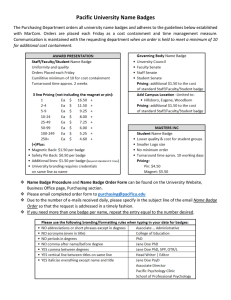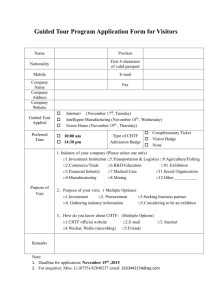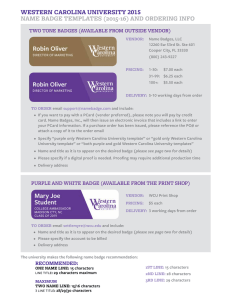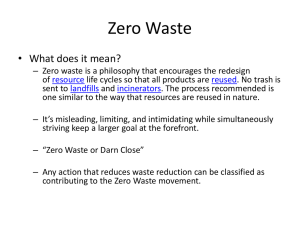Radiation Monitoring Badge - User Guide
advertisement
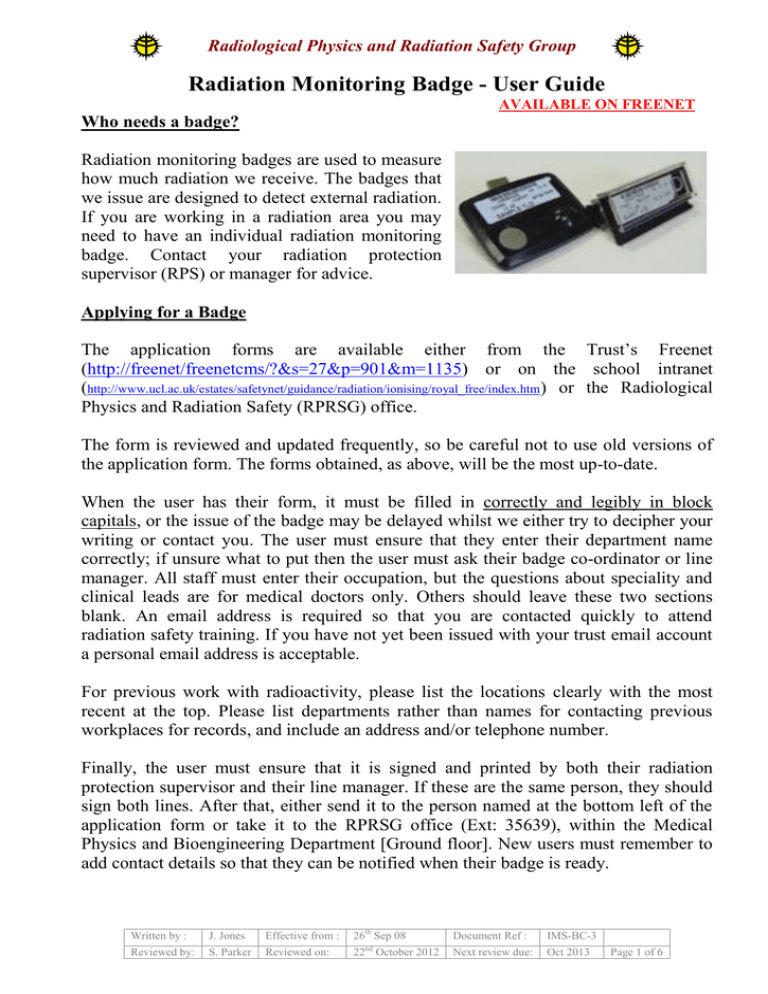
Radiological Physics and Radiation Safety Group Radiation Monitoring Badge - User Guide AVAILABLE ON FREENET Who needs a badge? Radiation monitoring badges are used to measure how much radiation we receive. The badges that we issue are designed to detect external radiation. If you are working in a radiation area you may need to have an individual radiation monitoring badge. Contact your radiation protection supervisor (RPS) or manager for advice. Applying for a Badge The application forms are available either from the Trust’s Freenet (http://freenet/freenetcms/?&s=27&p=901&m=1135) or on the school intranet (http://www.ucl.ac.uk/estates/safetynet/guidance/radiation/ionising/royal_free/index.htm) or the Radiological Physics and Radiation Safety (RPRSG) office. The form is reviewed and updated frequently, so be careful not to use old versions of the application form. The forms obtained, as above, will be the most up-to-date. When the user has their form, it must be filled in correctly and legibly in block capitals, or the issue of the badge may be delayed whilst we either try to decipher your writing or contact you. The user must ensure that they enter their department name correctly; if unsure what to put then the user must ask their badge co-ordinator or line manager. All staff must enter their occupation, but the questions about speciality and clinical leads are for medical doctors only. Others should leave these two sections blank. An email address is required so that you are contacted quickly to attend radiation safety training. If you have not yet been issued with your trust email account a personal email address is acceptable. For previous work with radioactivity, please list the locations clearly with the most recent at the top. Please list departments rather than names for contacting previous workplaces for records, and include an address and/or telephone number. Finally, the user must ensure that it is signed and printed by both their radiation protection supervisor and their line manager. If these are the same person, they should sign both lines. After that, either send it to the person named at the bottom left of the application form or take it to the RPRSG office (Ext: 35639), within the Medical Physics and Bioengineering Department [Ground floor]. New users must remember to add contact details so that they can be notified when their badge is ready. Written by : Reviewed by: J. Jones S. Parker Effective from : Reviewed on: 26th Sep 08 nd 22 October 2012 Document Ref : IMS-BC-3 Next review due: Oct 2013 Page 1 of 6 Radiological Physics and Radiation Safety Group If you already have a badge issued for this site and wish to change the badge location to a different department, please inform us before sending us a new application form. This will avoid duplicate issues. In order to comply with Regulation 15 of the Ionising Radiations Regulations 1999, we need to identify staff working with ionising radiation at other hospitals or working on site with a Non-Trust employer. Please complete the relevant section on the badge application form. You MUST give us accurate information about where else you work, otherwise the trust may be unable to comply with the law. Ensure that you wear the radiation badge issued at the Royal Free only for work at the Royal Free sites. First badge When the user’s form has been submitted and accepted, they will be contacted to go to the Radiation Safety office in order to collect their new badge. This will be either after the user has sent their form, or, if they took it there, after the form has been processed. Either way, the user will have to come to the office to sign for the badge. When the user receives their badge, they will be given either a thermoluminescent dosimeter (TLD) or a film badge and holder. A small number of workers will receive two finger ring monitors for their hand extremity monitoring. These will have ‘ULE’ and ‘URE’ on them. The ‘ULE’ ring should be worn on the middle finger on the left hand. The ‘URE’ ring should be worn on the middle finger of the right hand, next to the palm. Suitable ring sizes can be requested for every user. The user will be asked to sign a sheet in a column called ‘Wearer Sign’. Once done, the user will receive their badge. The whole body badge should be worn on the front of the torso, usually at the waist and not at the sides or back. It should be underneath any protective clothing such as Pb/rubber aprons used in radiology – the idea is to measure the dose that you receive. Some staff in radiology will also be issued with a badge to wear at collar level, usually in a Red holder. This is to measure doses received outside of areas covered by Pb/rubber aprons, in particular the dose to the eyes. The inserts for these badges are marked with the letter ‘C’ so that they are easily distinguished from the badge worn underneath aprons. Collar badges must be worn as close to the collar as possible e.g. clipped to the thyroid shield. They should NOT be worn on the sleeve since this Written by : Reviewed by: J. Jones S. Parker Effective from : Reviewed on: 26th Sep 08 nd 22 October 2012 Document Ref : IMS-BC-3 Next review due: Oct 2013 Page 2 of 6 Radiological Physics and Radiation Safety Group will grossly overestimate eye dose. We know how the dose at collar level relates to the eye dose so you must wear the monitor in the correct position or these estimates will be wrong. Figure 1: Radiation body badges are worn on the torso, usually at waist level as shown. If you are issued with both body and collar monitors, it is really important that you do not get them mixed up. Otherwise it may appear that you got a significant whole body dose and you will be subject to investigation by your line manager. The badge(s) should be worn during the working day and they MUST BE WORN AT ALL TIMES when working with radiation at the trust, whether radionuclides or radiation fields (e.g. x-ray machines). You must look after your badge. If it is damaged or contaminated, let your badge coordinator know straightaway and also contact the RPRSG team for further advice or a replacement badge. Make sure that you do not leave it or store it in radiation areas. Don’t let it get splashed with radiological, chemical, or biological substances. Wear it underneath sterile gowns or plastic aprons. RPRSG will send details of new users to the Staff Education and Development Centre(x35936). New users must attend the IRR99 training every two years. Course information and application form is found on Freenet (http://freenet/freenetcms/default.aspx?s=48&p=1553&m=2184&cal=1549&cid=5). Note that this is not an equivalent to the IRMER training. Subsequent badges. These will be delivered to the badge co-ordinator for your department or group shortly before the start of the new month. Each co-ordinator will distribute the badges according to their own local procedure. However, they will also receive a sheet with the name of each person in that department who is registered for radiation monitoring. Upon being given their subsequent badge, the new user will date the ‘Issue Date’ and sign next to it to confirm receipt of all badges stated against their name. They will then hand back their previous month’s badge and date the ‘Return Date’ and sign next to it to confirm return of all badges stated. Note that the ‘Issue Date’ and ‘Return Date’ columns relate to a specific month on the sheet. TLD and finger badges will simply be exchanged. For film badges, the user will open the holder using the clips at the back. (Pull them gently apart to open the holder.) Remove the film and hand that over to the co-ordinator. Place the new film in the holder, be careful to insert the badge with the correct orientation – you should be able to see the printed label through the badge window, and snap it shut. It should be noted Written by : Reviewed by: J. Jones S. Parker Effective from : Reviewed on: 26th Sep 08 nd 22 October 2012 Document Ref : IMS-BC-3 Next review due: Oct 2013 Page 3 of 6 Radiological Physics and Radiation Safety Group that the badge labels have a different colour for each month and the user should check that they are receiving and handing back the correct colour/date, name. Make sure body and collar monitors are the correct way round. Established users will date and sign the return sheet for the previous month, corresponding with the badges that they are now returning. If your name is not listed on the issue/return sheet, enter your name, date and sign towards the end on the appropriate sheet. The badge co-ordinator will also sign to confirm that they have received the badges before returning them to RPRSG for processing. The badge coordinator will enter problems/reasons/comments under comments section. If a user knows that they will be absent at the next change-over time, they must pass their badge to the co-ordinator in advance, as close to the change-over time as possible, but not until all radiation work has been completed. If the user was absent at the change-over time but did not have advance notice (e.g. through illness), please change the badges as soon as possible when back at work. Also, the user should notify their badge co-ordinator if possible (e.g. when phoning in sick, asking the message to be passed on). If a user keeps their badges in a lab coat or other uniform, they must ensure that all badges are removed before sending the uniform off to the laundry. Users must also notify the badge co-ordinator, line manager if they have reason to believe that the badge may show an incorrect result (e.g. the user forgot to wear the badge or left it in a radiation area). They can contact RPRSG for further advice or a replacement badge. Dose reports will be sent to the radiation protection supervisor (RPS) and line manager. The Line Manager will be responsible for distributing the results, reviewing them and making investigations of any anomalous readings in collaboration with the RPRSG. Individual users can view their own dose results online by signing up with our Approved Dosimetry Service (Mirion Technologies). Mirion provides a secure, easy and convenient way for you to access your dose history online with My Dose Records (MDR). The link to sign up for this is: https://www.dosimetry.com/myaccount/register.html Problems If a user cannot return or collect their badge, they must inform their badge co-ordinator of this fact, along with reasons why. As is stated on the application form, a user is liable for all costs associated with a lost badge. If a user fails to collect or return a badge, a valid reason must be given to the coordinator and the facts will be reported to the departmental line manager by the badge Written by : Reviewed by: J. Jones S. Parker Effective from : Reviewed on: 26th Sep 08 nd 22 October 2012 Document Ref : IMS-BC-3 Next review due: Oct 2013 Page 4 of 6 Radiological Physics and Radiation Safety Group co-ordinator. Three non-returns or non-collects in a calendar year will be escalated to the local Radiation Governance group, which is usually chaired by the departmental manager. More than three non-returns or non-collects are escalated to the Radiation Board. This may lead to disciplinary action.. This follows local procedures as stated in the Departmental Badge-o-gram. Lost badges should be reported to the coordinator and the line manager(s) as soon as possible. In this case, a user must request a replacement badge from RPRSG. The same applies for damaged badges or badges sent through the laundry, even if they come back. If you suspect an overexposure on the badge, let us know immediately so that the situation is investigated. Note that your badge may need to be sent off for an urgent read-out. Other types of monitoring Electronic personal dosemeters (EPD), are sometimes issued. As with other badges these must be worn as directed with the front of the EPD directed towards any radiation. These dosemeters are normally worn between waist and shoulder levels. These ‘active’ dosemeters are very much more expensive than the usual ‘passive’ badge monitors and extra care must be taken to ensure that they do not get misplaced. They are also more readily damaged so treat them with care. The operating instructions are quite complex and you should always make yourself familiar with the correct operation of these radiation monitors. Prenatal safety An unborn child is more sensitive to the affects of radiation exposure, due to the rapidly dividing cells that naturally occur during development, and therefore lower radiation dose limits apply. It is HIGHLY recommended that any user finding that she is pregnant inform her manager immediately, preferably in writing, both to allow more careful monitoring and so that a risk assessment can be made and, if necessary, changes to duties implemented. If she is unwilling to notify a manager, she can still notify RPRSG, who will keep such information completely confidential. Once RPRSG has received notification of a Written by : Reviewed by: J. Jones S. Parker Effective from : Reviewed on: 26th Sep 08 nd 22 October 2012 Document Ref : IMS-BC-3 Next review due: Oct 2013 Page 5 of 6 Radiological Physics and Radiation Safety Group pregnancy, we will monitor the user closely, notifying them immediately of any untoward doses. A pregnant user should wear their badge at abdomen level to allow a better evaluation of foetal dose. A special foetal monitoring badge will be issued on request. CONTACT Staff Education and Development Centre ON extension 35936 to Book and Attend the IRR99 course. Written by : Reviewed by: J. Jones S. Parker Effective from : Reviewed on: 26th Sep 08 nd 22 October 2012 Document Ref : IMS-BC-3 Next review due: Oct 2013 Page 6 of 6
